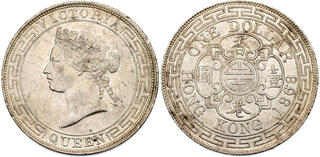Lot description:
Hong Kong. Dollar, 1868. Dav-245; KM-10; Prid-3. Queen Victoria. Crowned portrait facing left, her hair tied in a bun and bound by a ribbon, its ends fluttering behind her neck, this image dominating the obverse side of this, the largest coin struck for the British Crown Colony; within the surrounding enclosed circle, VICTORIA at top and QUEEN at bottom, separated by a geometric scroll, the entire motif within a beaded border and high rim. On the reverse side, the same geometric scroll and style of rim entirely surrounds a stylish quatrefoil center containing Chinese characters standing for the English legend around it, ONE DOLLAR at top and HONG KONG 1868 at bottom. Edge is reeded (milled). Pop 11; 2 in 62; 1 in 64. NGC graded MS-61. Estimated Value $7,500 - UP
Today's bustling, modern harbor city along the coast of southern China was once a main island and some 230 adjacent islets near Kowloon south of the Shenzhen River (known as the New Territories) whose residents were fishermen, farmers, "charcoal burners," pirates and opium smugglers. It was a primitive place of wooden structures. Near the end of the first Opium War, in 1841 Great Britain's navy seized control for the Crown, creating a free port that offered safety for traders of all kinds (especially in silver and opium, then legal in Great Britain as a curative) while mainland China remained the domain of war lords. It was unstable while Hong Kong was controlled, and under these conditions the little city flourished. The capital was called Victoria. Britain's possession expanded in 1860 to include the peninsula and Stonecutters Island, securing the harbor. In 1898, China granted Britain a 99-year lease.
As Hong Kong grew, so did its need for money of more kinds and in greater quantity. From the time of the Opium Wars (1839) onward, the "Spanish dollar"-made from silver ore mined in Mexico, Peru and Bolivia and shipped around the globe-had been used as an accepted standard of monetary (intrinsic) value. These coins were all based on what was called the imperial sterling standard: in other words, they could be trusted to be of solid value. Merchants accepted them and often counter-stamped them (with "chopmarks") to denote acceptance. Beginning in 1863, British-styled coinage began to be issued by London's Royal Mint for the colony-bronze cents and silver 5-cents, 10-cents, 20-cents, a much larger coin variously called a half-dollar and 50-cents, and (for a brief time only) One Dollar pieces. Designs were similar among the denominations but the dollar's styling was the most elaborate (though almost identical to the briefly issued Half Dollar of 1866-68). The dollar size was minted only during 1866, 1867 and 1868. It was the result of pressure from both officialdom and merchants for what was called an Anglo-Chinese Dollar and it was made at a branch of the Royal Mint at Hong Kong which opened in 1866. The currency system was a success but the Hong Kong Mint failed as a venture, its equipment sold to the new mint in Osaka, Japan, that issued its own competing Trade Dollar (Yen) which, although it was beautiful and of fine quality, never found acceptance outside of Japan. Chinese merchants disliked it so much that they discounted it increasingly month by month, causing the Hong Kong Mint to close permanently in 1868. After that year, coins for the colony were again produced at the Royal Mint in London as well as by private mints in England contracted to supply Hong Kong with its needed hard money. Of all the British coins made for use in Hong Kong, the lovely silver dollar of 1866-1868 remains the most desired by collectors worldwide. Most of the mintages entered circulation. "Mint State" and only slightly used pieces are quite rare. They are the best examples of British issues for the colony. |  |